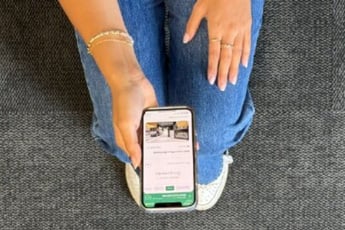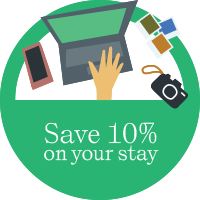How to save money for travel without giving up your coffee habit
If you read any blog post out there with money saving tips for travel, they all parrot the same advice: Stop. Drinking. Expensive. Coffee.
The idea is simple: if you spend $5 on coffee every day, you’re spending $150 per month or $1800 per year that you don’t really need to be spending. Well, sorry, guys. I love expensive coffee and there’s just no way I’m giving it up. That’s two grand that I’m willing to part with.
If you’re anything like me, you love coffee too, and you won’t want to give it up either. Though, I’ll be honest with you, it isn’t really about the coffee. It’s about the fact that I love coffee, and these people are telling me to stop drinking it.
Well I think that’s bullsh*t. There is no reason we can’t enjoy the things we like and travel at the same time.

The real problem we encounter when trying to save up money for travel isn’t actually our inability to save, it’s how good we are at spending. We don’t take an honest inventory of what we’re buying and what we’re spending. We pay for things blindly, only thinking afterwards (usually with quite a bit of shock) about how much we actually spent.
Ramit Sethi is the financial advisor we all wish we had. His New York Times Bestseller, I Will Teach You to Be Rich, has some insanely relevant and practical advice for 20-somethings like us. He’s also funny as hell. The title is salacious, I know, but its pages are gold. This book has probably made more of an impact on my adult life than anything else I’ve read. Ever.
Sethi lays out exactly how we should be structuring our finances as young professionals. His advice isn’t about how to save as much money as you can, it’s about balancing your life and your finances so that you always have the money you need to do the things that you want. The crux of his spending plan is actually quite simple.
You just have to spend the time to allocate your finances in advance so that you’re only left to spend the money that’s actually in your account. It’s like you’re working backwards, instead of looking back to figure out how much you spent each month, you look forward and decide how you’re going to spend the money you know you’re going to have.

Step 1: Restricting spending vs. prioritising your interests
The problem I have with these guides to saving money for travel is that they focus on restriction. When we restrict ourselves, we don’t live an enjoyable life, yet the whole reason we’re travelling is because we want to have fun. Does that make sense to you?
Most people who save up money fast admit to leading a very bleak and difficult life in the process. I enthusiastically applaud those people for achieving this goal; it shows true grit and determination. If you want to save up money for travel, sure, you could cut every last expense you have and save every dime. But it’s not a reasonable or sustainable approach for the majority of people.
You don’t have to be miserable during the saving phase just so you can appreciate the travel phase!
Instead of cutting things out and focusing on restriction, you should instead be more focused on spending money on the things you love. It’s pretty straightforward, actually. Make more room in your life for the things you like, which leaves less room for the things you don’t. Not only is this good money advice, it’s good life advice.
It’s funny because we learn so many things in school about how to make money when we’re older, but we learn almost nothing about how to actually manage the money that we make. My parents never taught me how to handle my finances, and I’ve made some costly mistakes because of it.
My guess is that nobody ever sat you down and showed you how, either, and that's exactly what I'm going to do now. Let’s do an exercise. Write down all of your monthly expenditures. Seriously, grab a piece of paper or open a text document on your computer and start writing. I’m serious.
Write down every single thing that you spend money on every month, and add it all up. Now figure out which ones are your high priority expenses and which ones are your low priority expenses, and put them in different lists. Do you see any trends?

Step 2: A spending plan that helps you save money for travel
Once you’ve figured out what you’re actually spending every month, you can start to look at how you’re spending it. Use the guidelines below and compare your current spending trends. How much more or less do you need to spend in each category to hit the targets?
Rent, bills, groceries, loan payments and other essentials should cost about 50% of your take-home pay. How does your total number compare to this? You might need to adjust your lifestyle if you’re spending more than this. If it’s less, good on ya!
The money you spend every month should be somewhere between 20-30% of your take-home pay. Take a look at your list, is your total spent monthly about half of your rent/essentials? It should be.
Your savings for travel should also be about 20-30%, but you can reduce this to as little as 10% if you’re happy to spend more on your day-to-day life and save a little bit less. It all depends on your goals.

At the beginning of every month, pay your rent, pay your credit cards, and transfer money into your savings account. Once you’ve paid for your essentials, whatever is left over in your account afterwards is everything you get for the month. You can safely run your account down to zero, knowing that you've already paid for and saved everything you need to.
The rule with your left over spending money is that you are only allowed to spend it in exactly the way that you decide in your spending plan. Let’s say you have $500 left over to spend every month. If you allocate $200 for going out with friends, once you use up the fund, you’re not allowed to go out anymore. You have to be willing to decline and spend a night in with Netflix instead.
If you overspend on going out, then you give up something else, which is exactly what we’re trying to avoid; giving anything up. So you have to look at your list of high priority and low priority items, and decide how much you can spend on each item.
Can you reduce any of your low priority expenses while keeping your high priority ones? After doing some math, you may realize that you have to restructure your lifestyle a little, but you don't have to give up the things you love. Just don't forget to leave yourself a bit of cash for random, day-to-day expenses. You want to have some money left over to play with.
Following these basic guidelines, I’ve managed to save a few thousand dollars in just a couple of months (while paying off credit cards and travelling at the same time). The best part is that you only have to do this restructuring one time with small bits of maintenance and tweaking along the way. In complete honesty (and I’m not just saying this because it sounds good), a couple hours of your time could end up paying for your next vacation.

Step 3: Saving money while you're actually travelling
A few months down the line, once you’ve reached your savings goal and you’re ready to go travel, please don’t see this as an opportunity to splurge. The basic rules of money (unfortunately) still apply. You should follow the same structure of prioritization, and work out how much of your budget you’re ready to spend on each facet of your trip.
Different countries have different prices for things like food and accommodation, so you’ll need to take this into account as well. Sometimes, depending on the country, it can work really well in your favour. If you decide that you’re going to budget $30 per day in Thailand, work out how much everything costs ahead of time, allocate the appropriate funds, and whatever money is left over is what you get to play with.
If there are certain things that you value, continue to prioritize them! If you want to keep drinking $5 coffee, include that in your travel spending plan up front.
I travelled all over Australia and I chose budget-friendly accommodation options from YHA. To be honest, I didn't feel like I sacrificed any comfort at all because YHA has a network of clean, well-maintained, and comfortable hostels all over the country. And they actually contribute positively to the travel experience!
When you follow the same guidelines while you’re travelling, you realize that you’re not giving anything up at all, you get to enjoy everything that you want and you get to spend your money however you like. You just have to choose where it goes ahead of time.

You can read more of Jeremy’s work on his blog, Travel Freak.
Book direct and save
By booking direct with MyYHA you'll receive our exclusive discounted rates. Sign up or login to get 10% off at select properties.


